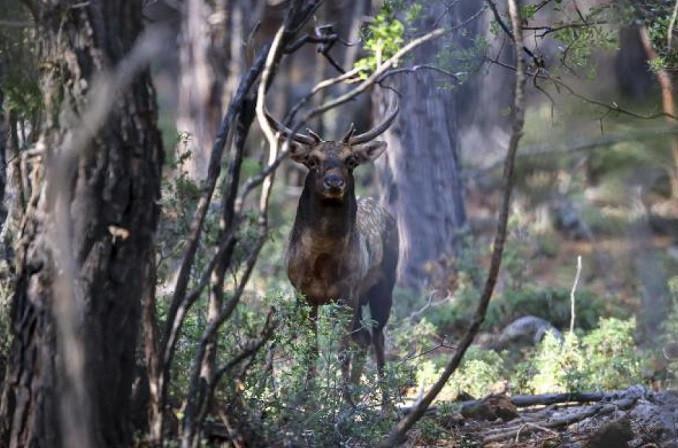Fallow deer habitat grows in Turkey
ANKARA

Turkish Agricultural Minister Bekir Pakdemirli said that 23 fallow deer that will be released into nature in the western Manavgat and Köyceğiz districts are now in an adaptation process.
According to a statement, the Agriculture and Forestry Ministry’s General Directorate of Nature Conservation and National Parks (DKMP) General Directorate continues works for the protection, production and release of fallow deer, whose homeland is Turkey.
In this context, 15 fallow deer to be released to nature in the southern province of Antalya’s Manavgat district and eight fallow deer to be released in the western province of Muğla’s Köyceğiz district were included in the 10-day adaptation process.
In the Manavgat-Kapan region, which was declared as the Fallow Deer Placement Area, it was planned to place 15 male and 15 female fallow deer, which were produced at the Eşen Island Fallow Deer Breeding Station.
In this context, an adaptation area of 3,200 square meters in size, surrounded by a two-meter-high mesh fence, with areas suitable for animal hiding and feeding, was created.
In order to prevent the animals from seeing the external environment, a two-meter-high shadow tulle curtain was hung. Also, feeding trough, irrigation system and mangers were also placed to meet their water needs.
The program is planned to be carried out in April-May for male fallow deer and September-October for the females.
Fifteen male fallow deer, caught by traps at the Eşen Island Fallow Deer Breeding Station were brought to this adaptation area where they will be released by an expert team, which performs all the necessary operations, such as the collection of tissue and blood samples.
Within the framework of the works, DKMP teams attached collars to six fallow deer to monitor them and also took caravans to the area to closely follow their 10-day adaptation process. In the end of the adaptation process, the deer will be released to nature.
Eight male fallow deer caught in Antalya Düzlerçamı region were taken to the adaptation process to be placed in Muğla - Köyceğiz Wildlife Development Area.
Placement works started in the region in 2013 and a total of 24 fallow deer were placed with these eight fallow deer. According to the findings, 36 fallow deer live in the area.
Works continue to produce fallow deer
“The fallow deer in Antalya Düzlerçamı, the ancestor of other fallow deer in the world, have been in danger of extinction in recent years,” said Pakdemirli in the statement.
Pakdemirli said that the first work to transfer the species to the next generations and to increase their population started in 1966 with the declaration of 1,750 hectares of land in the region a wildlife protection area. Later, the Düzlerçamı Alageyik Breeding Station was established next to the natural habitats in 1970, he added.
“Production activities started with a total of seven fallow deer and continued until 2003. Due to the increase in the number of fallow deer and the decrease in the nutrient plants in the production center, the production studies continued in a new area in Düzlerçamı-Eşen Island region,” Pakdemirli said.
Stating that the production studies with 110 fallow deer are still continuing at the Eşen Island Fallow Deer Breeding Station, Pakdemirli said, “The fallow deer that we will release in Manavgat were also produced in this production station. We have done transfers to other places before. We have released deer from this station to the Dilek Peninsula National Park and Muğla Köyceğiz Wildlife Development Area. We estimate that there are 300-350 fallow deer in our country, together with the ones outside the station. As the ministry, we take every precaution to ensure that this endemic species does not disappear. Twenty-three fallow deer that will be released to nature in Manavgat and Köyceğiz were included in the adaptation process.”
















